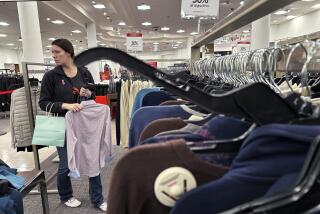Purchasers’ Index Points to Continued Expansion
- Share via
NEW YORK — An index of future economic growth showed expansion during June, with increased production and higher employment, although the results didn’t match the previous month’s strength, a trade group of corporate purchasing managers said Sunday.
The composite index of leading indicators fell slightly to 57.3% in June from 57.5% in May, when it posted its best showing in three years, the National Assn. of Purchasing Management said.
A reading above 50% generally indicates the economy is expanding, while one below indicates a decline, the group says.
“As expected, the second quarter ended with favorable growth. Although June’s growth may have been aided by inventory building where certain commodities were in short supply,” said Robert Bretz, chairman of the group’s business survey committee.
“The continued increase in new orders suggests a healthy beginning for the second half of 1987,” he said.
All indicators were up in June, including inventories, which rose slightly for the first time since July, 1984, Bretz said. The increase was possibly spurred by a buildup aimed at preventing growing shortages in steel, plastic resins and other raw materials.
The index consists of business indicators gathered from a monthly survey of executives in charge of buying materials and products at 250 industrial companies. The group has about 30,000 members.
In its survey, the group found:
- New orders rose, although not as much as in the previous two months, with 35% of the respondents reporting higher orders, compared to 15% reporting lower orders. That left a positive margin of 20 points, compared to 23 points in May and 28 points in April.
- In production, 32% reported improvement and 13% reported a deterioration, for a positive margin of 19 points, compared to 22 points in May and 27 points in April.
- Vendor deliveries slowed for the eighth-straight month, indicating continuing shortages of steel products. Five percent reported faster deliveries, and 15% reported slower deliveries, for a difference of 10 points, compared to a gap of 9 points in May and 4 points in April.
- Nineteen percent of all respondents reported higher inventories and 17% reported lower, leaving a positive margin of 2 points. That compared to a gap of zero in May and a gap of 4 points in April. A buildup of inventories indicates optimism, but also can be a drag on future production because factories can sell product off the shelves instead of producing more.
- Employment increased in June for the fourth-straight month after 29 months of no reported increase. Eighteen percent reported higher employment and 12% lower, for a net gain of 6 points, compared to 6 points in May and 10 points in April.
- Lead times, an indicator of buying policies, declined for production materials but rose for capital expenditures after falling off for three consecutive months. Lead times for maintenance, repair and operating supplies were unchanged.
- Among specific commodities, only natural gas was down in price. Reported in short supply were steel--particularly galvanized, coated and cold rolled sheets--polystyrene, plastic resins and caustic soda.
More to Read
Inside the business of entertainment
The Wide Shot brings you news, analysis and insights on everything from streaming wars to production — and what it all means for the future.
You may occasionally receive promotional content from the Los Angeles Times.










